Since my last post the buds on the trees have become more visible and definitely more green. The shrubs have started to grow back again as well. No real sings of return of wildlife, I didn’t see my duck friends from the beginning of the year in my early posts yet but I bet they’ll be back soon. My spot is kinda cool because it is a cross section of nature and culture. It’s right off of the bike path so plenty of people are riding around walking dogs and what-not. It’s also a pretty cool looking spot so lots of people tend to explore around the peninsula. There is also a beach to the side of the peninsula so people often run around and explore on the beach. At this point I feel like a part of my spot as I’ve been visiting so much. I also spent a lot of time exploring down by the waterfront near my spot at the beginning of the year. At this point it feels kinda like one of the cool hangout spots I had as a kid in the woods and it feels pretty homey. I’mm gonna miss it over the summer but I will definitely be visiting it again when I return in the fall.
Earth Week!


The snow is all gone from my spot on the water at this point! The ice is gone in the lake by now too. The trees have started to show signs of little buds poking out on the trees but not a whole lot yet and they are definitely pretty small. The grass is very green just off of my peninsula too. I noticed a snowdrop growing just off of my peninsula by a tree as well, but nothing is really growing on the peninsula that I can see yet.
Spring Break Phenology
Over spring break the phenology spot I chose was in my backyard in Middlebury Vermont. The Area used to be a sheep farm, this is evident through the relatively young forest and the old stone walls way back into the woods. The woods in my backyard are predominantly made up of white pines but we do have a few scattered sugar maples and I was able to find a couple birches and a red maple near the edge. It was hard to see if there were any animal tracks as my dogs have done a pretty good job tearing up the woods leaving a ton of tracks and scaring everything off. I was able to find a couple squirrel tracks and what I think may have been a rabbit track but it looked pretty old. This is a very different area than my phenology spot in Burlington. The most glaring difference was that there was no lake in my backyard. Secondly, the ground was a lot more solid than the rocky material of the peninsula. Lastly, there are certainly more animals living in my woods than on my peninsula and the trees and plants are a lot denser in my woods.
Wetland, Woodland, Wildland
When visiting my phenology site I decided to attempt and classify the type of natural community that it was using Wetland, Woodland, Wildland. IT is hard to classify this area as one of the many types of natural communities as it is a strange location for sure, being man-made and taken over by nature. The plants present definitely make it seem like an upland hardwood forest with plenty of hardwood trees such as maples and oaks, and lots of woody shrubs. Although, it is hard to classify this area as such as it is most definitely not a forest, being on a small rocky peninsula. It certainly has some wetland elements being right on the water and all, but again, it does not display enough of the characteristics of such a community to be called such, being on the rocky strip that it is. If I had to, I would describe the area as a small strip of upland hardwood forest, although I would propose a different type of classification, a manmade area retaken by nature. In my recent visit, a few phenological changes have occurred as well. the ice is a lot thinner now and the water is beginning to lap up on shore, additionally, the snow is starting to melt away. It is hard to see any new plant life growing yet but I bet it’s under there just waiting for some warm sunny days to start poking up.
First Phenology Site Visit After Break
When I returned to my phenology site on the waterfront there was a significantly greater amount of snow on the ground and the water on either side of my little peninsula was frozen. Additionally some buds were visible on the trees, here is a picture of a bud I found on a sugar maple tree at the edge of the site.
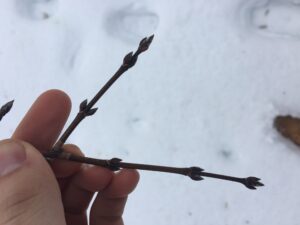
In addition to this maple there were a couple birches and an american beech tree or two hanging around on the peninsula. Here is a quick labeled sketch of one of the birch buds I found on a paper birch tree:
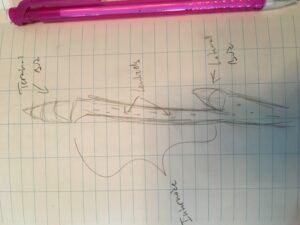
On my spot I found some very very common tracks of a human walking their dog in the snow at the edge of my site. This is not at all a rare occurrence as the site is right next to the bike path, but I am interested in why the two decided to diverge from the path into the snow.
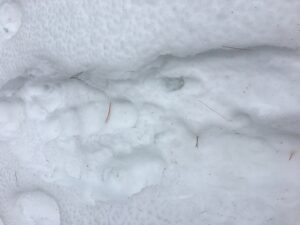
It appears as though a couple people have decided to take the same path as it was a little worn in, I’m not sure where it leads but it happens to go through the edge of my site, possibly to the water? In addition to these human made tracks I found a deer track leading into the bushes at the edge of my site. I was super surprised and also excited to see such tracks as I wouldn’t imagine deer would venture down into this section of Burlington where it is so busily inhabited.
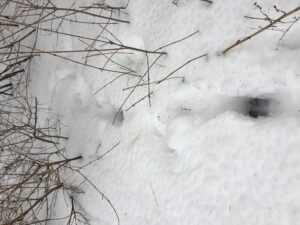
Judging by the track size I’d say this deer is a doe, or a large fawn, but most likely not a buck, although that would be super exciting! Since my last visit before break the site seems to have changed a little and gained some new visitors! It’s all very exciting and I cannot wait to see what spring brings with it and what new animals might visit my spot.
Human History
Off the end of my little peninsula, there are large concrete blocks that sit just above the water. The peninsula was also clearly man-made and overtime was taken back by nature. The peninsula is too perfectly shaped and in an unnatural location as well as made of large rocks and gravel in a way that doe snot normally happen in nature and not often in the form of a peninsula. I believe that the peninsula was laid down in order to get out into the water to place the pillar in. I also believe that the pillars were going to be the start of a new structure on the Burlington waterfront a long time ago, probably at the beginning of the cities formation, however, for some reason, this project was abandoned and the peninsula and pillars were left where they were. Over a good amount of time, the peninsula was taken over by some trees and shrubs making it the natural little spike out into the lake that it is today.
Phenology Site Back Home (written like Leopold)
As a young boy, I found myself at a hunting camp, nestled among the Adirondacks to the west and the Taconics on the east. Unlike a deer camp, this camp was made for teaching the hunt, and not for performing one. I made my way back to that very same camp every year since, and did the majority of my growing and learning there every summer. If one is to wake too early, with the geese, a golden glow can be visible careening down the eastern facing sides of all too rounded mountains to collide in turmoil at the base of a hill with the night’s blanket of cool fog. This process is slow, but if you blink you’ll miss the sharp pinks thrown skyward by such an explosion. In the afternoon, come time to sit down for dinner, these same rambunctious rays can be seen yanked back over the hills to the west as their fire orange arms reach out to grasp anything on the ground to help them stay in a spectacular struggle of mountain and sky. The hills of the camp itself cascade with the fluorescent greens of plants eager for the sun’s brutal warmth in a brawl for control of the fields and the forests. Underneath these arms of the mighty pine, maple, oak, and birch common on the hillsides crawl the residents of this hillside that are the reason we gather every summer at such a place. the deer scamper through the forests, the turkeys strut through the fields, the ducks glide silently through the lake, and the rabbits bound around the entirety of the place as if a dog were hot on their trail. And if one were to stay up too late, they would be accompanied by the coyotes that prowl the hillside and bask underneath the glorious moon and all of her sisters that float among the blackness of the sky.
Although I did not visit this place in July as I normally would, the November landscape was quite gorgeous still and evoked memories of the phenology site found on the waters of Lake Champlain. Both sites can be found near water, the camp, up a steep hill but not far, and the other directly on Champlain, although there lie most of the similarities. At camp, there are forests with much more diversity and many more trees making the site in Burlington look comparatively like a barren stretch of rocks, although both contain some maples. Both sites have also been found in the presence of ducks, however, if any other similar wildlife were found at both sites the discovery would not be without surprise. Both sites have reacted to the changes of the seasons in similar ways. Neither lake has frozen over yet and Champlain will most certainly not, however, Bomoseen will eventually. Additionally, the trees have found themselves looking quite similarly baren having lost their leaves, except for the pine found in the woods down the hill from camp. Lastly, they have both been impacted by the snowfall, laying a thick blanket of white down across all surfaces.
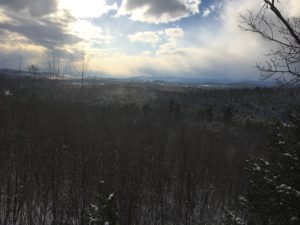
View from atop the small mountain that sits beside the camp.

looking out over the lake and into the snow beyond.
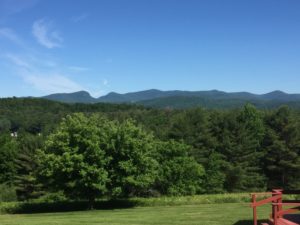
view of Taconics in July.
Link to google map of the camp.
Observations and Event Map
At my little peninsula, the water was much colder due to the temperature drop from the changing season. Many of the trees have lost most on their leaves and the rocks were slick from the slightly damp leaf cover. The few leaves remaining on the trees were vibrant colors and the 0nes on the group well a dead grey or brown. A lot of the shrubs seemed baren as well, as they too were preparing for their upcoming hibernation in the upcoming winter. The water was a little rougher than usual as the winds have picked up, although by no means were they exactly “rough”. The peninsula, although never thriving with life, was quieter than normal as the insects and many of the birds were much quieter than normal. The ducks were still there as usual, although it did not seem like they would be for long. While sitting there I wrote a haiku:
Sunlight between clouds
Wind excites chilled water
As ducks float gently

Phenology Site Bird’s Eye View

My phenology site is a rocky peninsula with a scattering of trees that pokes out into Lake Champlain just off the bike path.
Phenology Place Map
https://www.google.com/maps/@44.4864601,-73.2299618,160m/data=!3m1!1e3!4m2!6m1!1s1iiPsQSpqySRHRfe1baAIOlXDIE8nb5A7